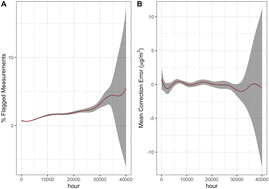An analysis of degradation in low-cost particulate matter sensors†
Abstract
Low-cost sensors (LCSs) are increasingly being used to measure fine particulate matter (PM2.5) concentrations in cities around the world. One of the most commonly deployed LCSs is PurpleAir with ∼15 000 sensors deployed in the United States, alone. PurpleAir measurements are widely used by the public to evaluate PM2.5 levels in their neighborhoods. PurpleAir measurements are also increasingly being integrated into models by researchers to develop large-scale estimates of PM2.5. However, the change in sensor performance over time has not been well studied. It is important to understand the lifespan of these sensors to determine when they should be serviced or replaced, and when measurements from these devices should or should not be used for various applications. This paper fills this gap by leveraging the fact that: (1) each PurpleAir sensor is composed of two identical sensors and the divergence between their measurements can be observed, and (2) there are numerous PurpleAir sensors within 50 meters of regulatory monitors allowing for the comparison of measurements between these instruments. We propose empirically-derived degradation outcomes for the PurpleAir sensors and evaluate how these outcomes change over time. On average, we find that the number of ‘flagged’ measurements, where the two sensors within each PurpleAir sensor disagree, increases with time to ∼4% after 4 years of operation. Approximately, 2 percent of all PurpleAir sensors were permanently degraded. The largest fraction of permanently degraded PurpleAir sensors appeared to be in the hot and humid climate zone, suggesting that sensors in these locations may need to be replaced more frequently. We also find that the bias of PurpleAir sensors, or the difference between corrected PM2.5 levels and the corresponding reference measurements, changed over time by −0.12 μg m−3 (95% CI: −0.13 μg m−3, −0.10 μg m−3) per year. The average bias increases dramatically after 3.5 years. Further, climate zone is a significant modifier of the association between degradation outcomes and time.

- This article is part of the themed collections: Outstanding Papers 2023 – Environmental Science: Atmospheres and A collection on dense networks and low-cost sensors, including work presented at ASIC 2022


 Please wait while we load your content...
Please wait while we load your content...